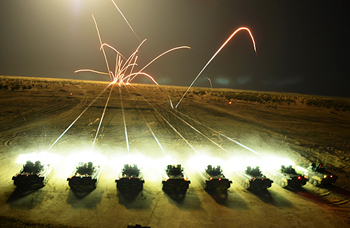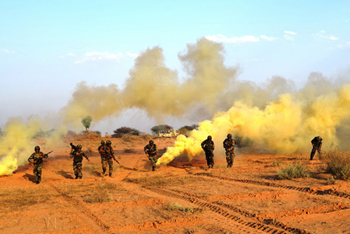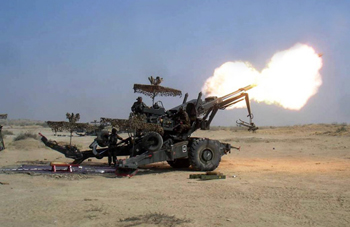INDIAN ARMED FORCES CHIEFS ON OUR RELENTLESS AND FOCUSED PUBLISHING EFFORTS

The insightful articles, inspiring narrations and analytical perspectives presented by the Editorial Team, establish an alluring connect with the reader. My compliments and best wishes to SP Guide Publications.

"Over the past 60 years, the growth of SP Guide Publications has mirrored the rising stature of Indian Navy. Its well-researched and informative magazines on Defence and Aerospace sector have served to shape an educated opinion of our military personnel, policy makers and the public alike. I wish SP's Publication team continued success, fair winds and following seas in all future endeavour!"

Since, its inception in 1964, SP Guide Publications has consistently demonstrated commitment to high-quality journalism in the aerospace and defence sectors, earning a well-deserved reputation as Asia's largest media house in this domain. I wish SP Guide Publications continued success in its pursuit of excellence.
- MoD initiates comprehensive review of Defence Acquisition Procedure 2020, pushes for defence reforms
- G7: The Swansong
- Kalinga Connect: South Asia to Polynesia
- Must Credit DRDO for Operation Sindoor, now what is next for defence R&D?
- The layered Air Defence systems that worked superbly, the key element of Operation Sindoor
- Operation Sindoor | Day 2 DGMOs Briefing
- Operation Sindoor: Resolute yet Restrained
Army Conducts Exercise Shatrujeet to Validate Strike Capability
Exercise Shatrujeet conducted by the Indian Army for the elite Strike l (1 Corps) in the deserts of Rajasthan






More than 30,000 soldiers have taken part in Exercise Shatrujeet conducted by the Indian Army for the elite STRIKE l (1 Corps) in the deserts of Rajasthan wherein the capability to strike deep in enemy territory in an integrated air-land battle environment is being tested. Exercise Shatrujeet is an operational-oriented exercise which is focused on validating integrated theatre battle fighting concepts incorporating new age technologies, weapon platforms and systems as well as long-range precision targeting vectors.
The Indian Army conducts a Strike Corps level exercise regularly for every Strike Corps so that their planning norms and methodology, their drills and procedures, use of force multipliers and new age technologies, efficacy of their mobile communications and other systems including air defence, and their responses to operational situations created on the battlefield can be monitored. This ensures that the formations concerned are kept in a high state of battle readiness and their drills and procedures are honed to near perfection. The build-up and preparatory training prior to the actual Corps exercise is carried out earlier. This includes unit and formation level exercises which are conducted during the six to eight weeks period preceding the main Corps exercise. This allows sub-unit, unit and formation commanders to check the efficiency of their own sub-units, units and formations including drills and procedures and responses to battle situations.
For example, in an armoured regiment of tanks, first the tank troop leader is given time to train with his three tanks without supervision, and similarly the squadron commander is given free time to train his squadron of 14 tanks and then the regimental commander trains with his 45 tanks. In independent armoured brigades and in the armoured division, the training is done in an integrated manner wherein with a regiment of tanks may be grouped one or two companies of mechanised infantry, a troop of tank trawls, an engineer platoon, an air control team with a tentacle, an air defence troop of air defence missiles on mobile platforms, and forward observations officers of artillery. All elements together form a combat group. An armoured brigade may comprise of two or three such armour/infantry heavy groups depending upon the missions in battle.
The formation and units are also made to undergo operational oriented training during this period using their actual war equipment. Such training manoeuvres at various levels, prepares the Strike Corps for the major exercise planned at the Corps level which comprises integrated operational manoeuvres to validate its operational plans in simulated high tempo battlefield environment and terrain.
The focus of the Corps exercise is to achieve joint and seamless coordination among all the forces in a nuclear, biological, chemical warfare scenario so as to deliver the enemy a lethal punch with full might at lightning speed. In order to achieve this aim, high-end technology and all the latest multidimensional modern weaponry at the disposal of the armed forces has been utilised. In the last decade or so, there has been a paradigm shift in India’s offensive doctrine and capability and such exercises are undertaken regularly by the Army to train its troops in their offensive role and weapon usage.
Detailed de-briefing sessions are held at unit and formation levels after the exercise to collect and collate the tactical and logistic lessons learnt in the exercise and the same are sent to the higher formations for further dissemination and to Army Headquarters for their use as considered appropriate.





